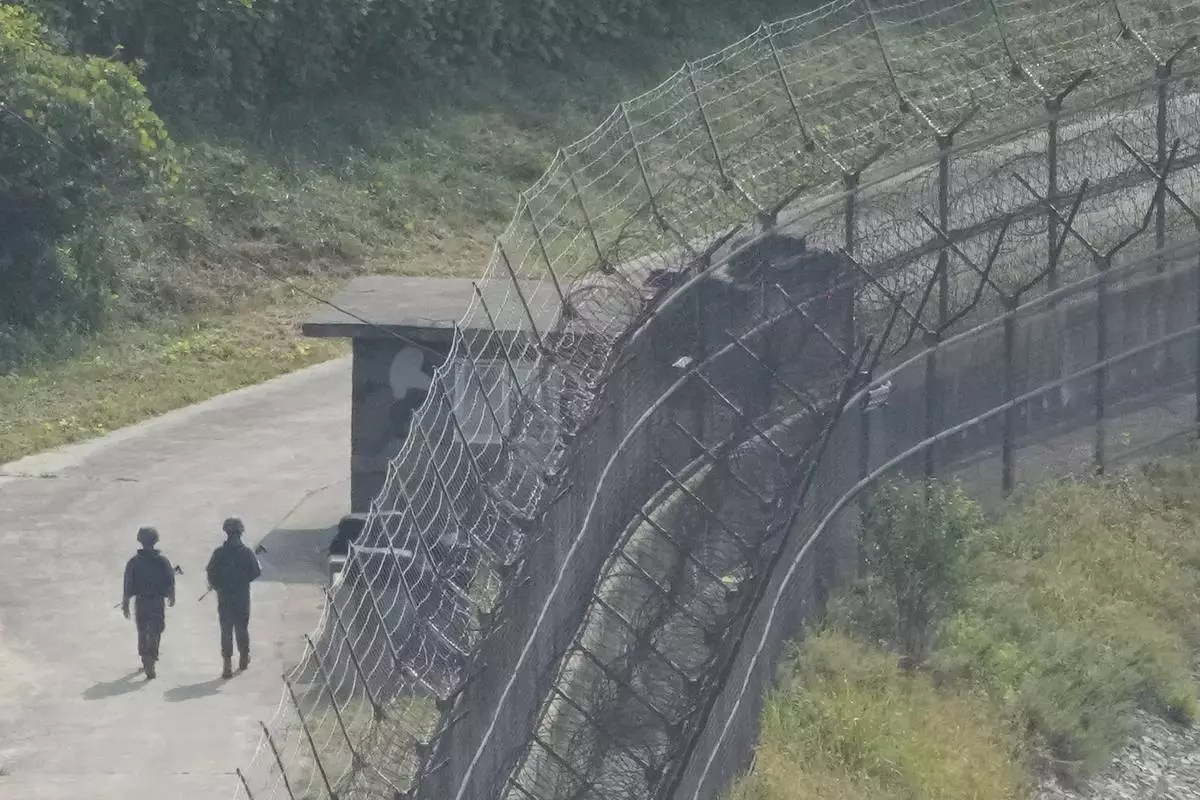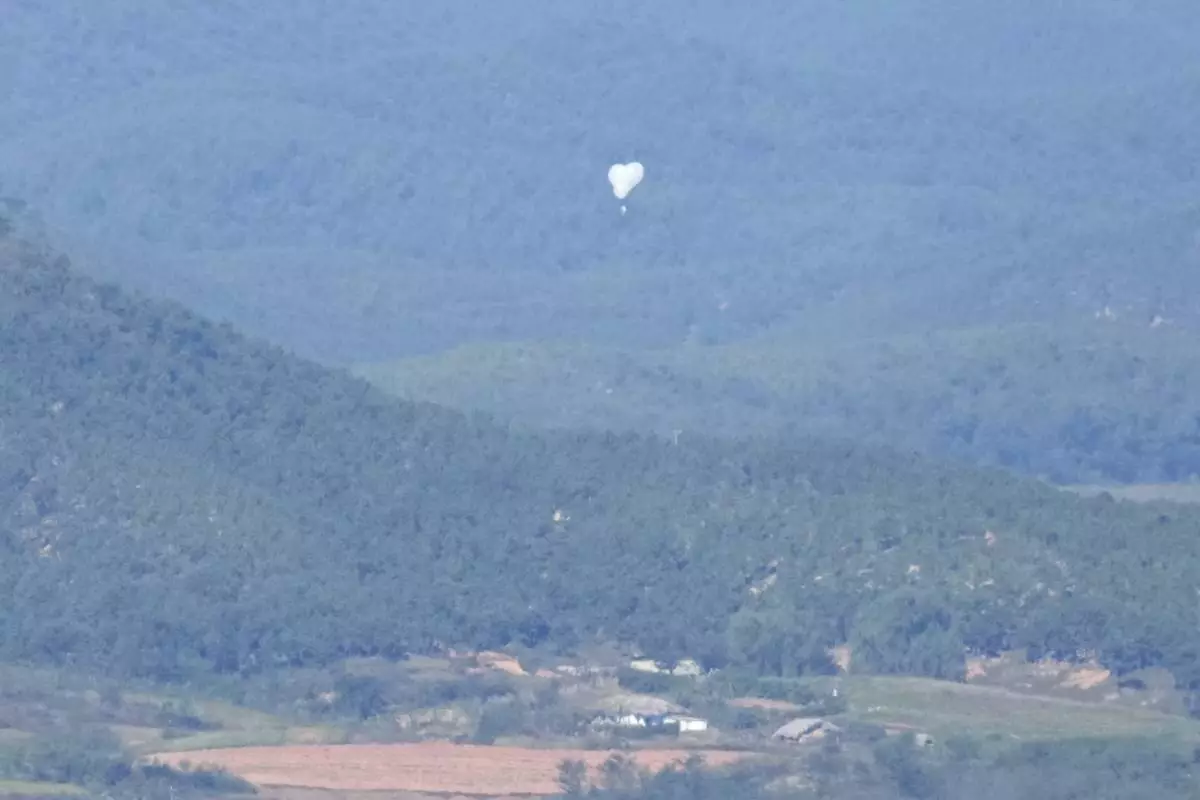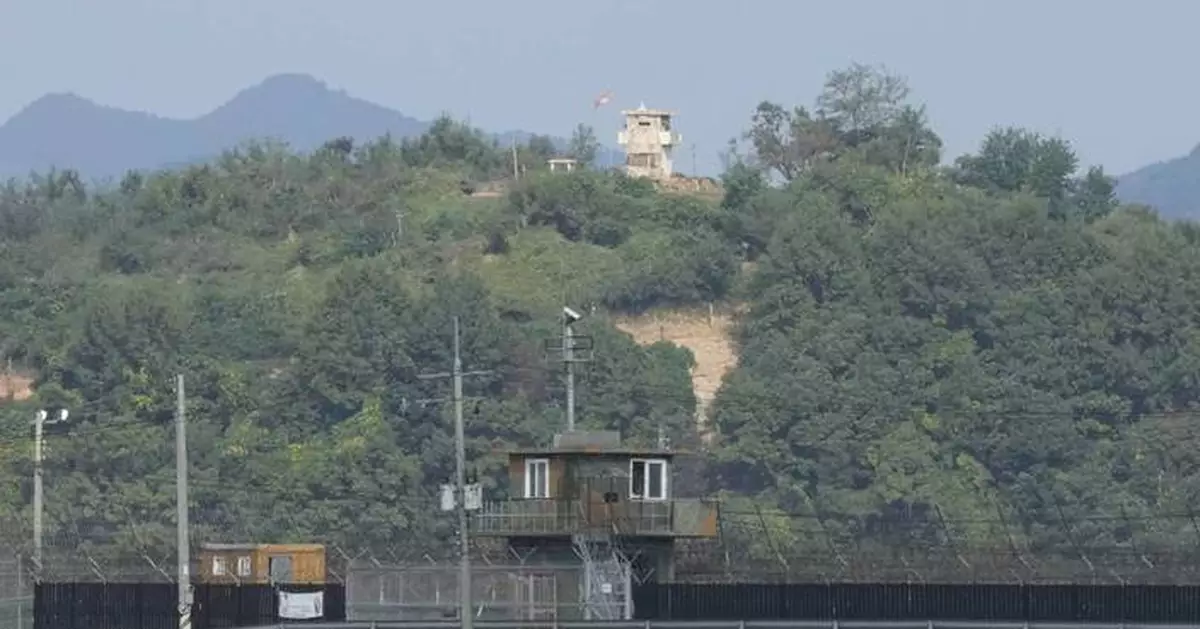SEOUL, South Korea (AP) — South Korea said Monday it has detected signs that North Korea is preparing to destroy the northern parts of inter-Korean roads no longer in use, as the rivals are embroiled in soaring tensions over North Korea’s claim that South Korea flew drones over its territory.
Destroying the roads would be in line with leader Kim Jong Un’s push to cut off ties with South Korea, formally cement it as his country's principal enemy and abandon the North's decades-long objective to seek a peaceful Korean unification.
Click to Gallery
A North Korean loudspeaker, top left, a military guard post, top right, and a South Korean military guard post, bottom, are seen from Paju, South Korea, near the border with North Korea, Thursday, Oct. 10, 2024. (AP Photo/Ahn Young-joon)
FILE - A North Korean military guard post, top, and a South Korean post, bottom, are seen from Paju, South Korea, near the border with North Korea, Thursday, Oct. 10, 2024. (AP Photo/Ahn Young-joon, File)
South Korean army soldiers patrol along the barbed-wire fence in Paju, South Korea, near the border with North Korea, Monday, Oct. 14, 2024. (AP Photo/Ahn Young-joon)
South Korean visitors look at a map which shows a border area of two Koreas with a railroad line between Munsan city in south and Kaesong in north, at the Imjingak Pavilion in Paju, South Korea, near the border with North Korea, Monday, Oct. 14, 2024. (AP Photo/Ahn Young-joon)
A North Korean soldier stands guard at the North's military guard post as a North Korean flag flutters in the wind, as seen from Paju, South Korea, near the border with North Korea, Monday, Oct. 14, 2024. (AP Photo/Ahn Young-joon)
Barricades are placed near the Unification Bridge, which leads to the Panmunjom in the Demilitarized Zone in Paju, South Korea, Monday, Oct. 14, 2024. (AP Photo/Ahn Young-joon)
A North Korean military guard post is seen from the Unification Observation Post in Paju, South Korea, near the border with North Korea, Thursday, Oct. 10, 2024. (AP Photo/Ahn Young-joon)
A North Korean loudspeaker, top left, a military guard post, top right, and a South Korean military guard post, bottom, are seen from Paju, South Korea, near the border with North Korea, Thursday, Oct. 10, 2024. (AP Photo/Ahn Young-joon)
South Korean army soldiers patrol along the barbed-wire fence in Paju, South Korea, near the border with North Korea, Thursday, Oct. 10, 2024. (AP Photo/Ahn Young-joon)
FILE - North Korean balloons are seen from the Unification Observation Post in Paju, South Korea, near the border with North Korea, Friday, Oct. 4, 2024. (AP Photo/Lee Jin-man, File)
FILE - A North Korean military guard post, top, and a South Korean post, bottom, are seen from Paju, South Korea, near the border with North Korea, Thursday, Oct. 10, 2024. (AP Photo/Ahn Young-joon, File)
In a highly derisive rhetoric, Kim's sister and senior official, Kim Yo Jong, called the South Korean military “dregs” and “mongrels tamed by Yankees.” She said Monday that “the master of those dogs,” an apparent reference to the U.S., must be held accountable for the alleged drone flights as well. South Korea and the U.S. had no immediate responses.
Earlier Monday, South Korea's military said that it was observing various activities in North Korea that appeared to be preparations for demolishing the roads, such as installing screens.
“They have installed screens on the roads and are working behind those screens, preparing to blow up the roads,” Lee Sung Joon, spokesperson of South Korea’s Joint Chiefs of Staff, told a briefing. He said the demolitions could be carried out as early as Monday.
Lee said that the South Korean military believes that North Korea may carry out other provocations like a space rocket launch, which the U.N. views as a disguised test of long-range missile technology.
It’s not clear how much parts of the roads North Korea would destroy.
During the previous era of inter-Korean detente in the 2000s, the two Koreas reconnected two road routes and two rail tracks across their heavily fortified border. But their operations later were suspended one by one as the Koreas wrangled over North Korea’s nuclear program and other issues.
Last week, North Korea said it would permanently block its border with South Korea and build front-line defense structures to cope with “confrontational hysteria” by South Korean and U.S. forces. South Korean officials said North Korea had already been adding anti-tank barriers and laying mines along the border since earlier this year. They said North Korea has also planted mines and removed lamps along its sections of the inter-Korean roads and taken out ties on the northern side of the railways.
North Korea has accused South Korea of launching drones to drop propaganda leaflets over Pyongyang three times this month and threatened to respond with force if it happened again. South Korea has refused to confirm whether it sent drones but warned it would sternly punish North Korea if the safety of its citizens is threatened.
In a statement Sunday, the North’s Defense Ministry said that the military had ordered artillery and other army units near the border with South Korea to “get fully ready to open fire.” The ministry said that the entire South Korean territory “might turn into piles of ashes” following the North’s powerful attack.
North Korea often releases warlike rhetoric when animosities with its rivals increase. Experts say it's highly unlikely for North Korea to launch full-scale, preemptive attacks as it military is outmatched by the combined U.S. and South Korean forces.
Koo Byoungsam, a spokesperson of South Korea’s Unification Ministry, said Monday that North Korea’s accusation over drone flights was likely aimed at creating tensions to reinforce its internal unity while stoking instability in South Korea. Koo said North Korea cannot win what it wants from South Korea with threats and provocations.
Some observers say anti-Pyongyang activists in South Korea might have sent drones this month, but North Korea argues the South Korean government cannot escape responsibility.
In 2022, South Korea sent surveillance drones across the border into North Korea after it accused North Korea of flying drones into South Korea for the first time in five years.
Tensions on the Korean Peninsula are at their highest point in years, with North Korea continuing a run of provocative missile tests and South Korea and the U.S. expanding their military drills. Observers say North Korea could perform major weapons tests ahead of next month’s U.S. presidential election to increase its leverage in future diplomacy with the Americans.
In January, Kim Jong Un ordered the revision of North Korea's constitution to eliminate the goal of a peaceful Korean unification, formally designate South Korea as the country’s “invariable principal enemy” and define the North’s sovereign, territorial sphere.
Kim’s order stunned many North Korea watchers because it was seen as breaking away with his predecessors’ long-cherished dreams of peacefully achieving a unified Korea on the North’s terms. Experts say Kim likely aims to diminish South Korea’s voice in the regional nuclear standoff and seek direct dealings with the U.S. They say Kim also likely hopes to diminish South Korean cultural influence and bolster his rule at home.

South Korean army soldiers patrol along the barbed-wire fence in Paju, South Korea, near the border with North Korea, Monday, Oct. 14, 2024. (AP Photo/Ahn Young-joon)

South Korean visitors look at a map which shows a border area of two Koreas with a railroad line between Munsan city in south and Kaesong in north, at the Imjingak Pavilion in Paju, South Korea, near the border with North Korea, Monday, Oct. 14, 2024. (AP Photo/Ahn Young-joon)

A North Korean soldier stands guard at the North's military guard post as a North Korean flag flutters in the wind, as seen from Paju, South Korea, near the border with North Korea, Monday, Oct. 14, 2024. (AP Photo/Ahn Young-joon)

Barricades are placed near the Unification Bridge, which leads to the Panmunjom in the Demilitarized Zone in Paju, South Korea, Monday, Oct. 14, 2024. (AP Photo/Ahn Young-joon)

A North Korean military guard post is seen from the Unification Observation Post in Paju, South Korea, near the border with North Korea, Thursday, Oct. 10, 2024. (AP Photo/Ahn Young-joon)

A North Korean loudspeaker, top left, a military guard post, top right, and a South Korean military guard post, bottom, are seen from Paju, South Korea, near the border with North Korea, Thursday, Oct. 10, 2024. (AP Photo/Ahn Young-joon)

South Korean army soldiers patrol along the barbed-wire fence in Paju, South Korea, near the border with North Korea, Thursday, Oct. 10, 2024. (AP Photo/Ahn Young-joon)

FILE - North Korean balloons are seen from the Unification Observation Post in Paju, South Korea, near the border with North Korea, Friday, Oct. 4, 2024. (AP Photo/Lee Jin-man, File)

FILE - A North Korean military guard post, top, and a South Korean post, bottom, are seen from Paju, South Korea, near the border with North Korea, Thursday, Oct. 10, 2024. (AP Photo/Ahn Young-joon, File)
The Christmas tradition has become nearly global in scope: Children from around the world track Santa Claus as he sweeps across the earth, delivering presents and defying time.
Each year, at least 100,000 kids call into the North American Aerospace Defense Command to inquire about Santa’s location. Millions more follow online in nine languages, from English to Japanese.
On any other night, NORAD is scanning the heavens for potential threats, such as last year’s Chinese spy balloon. But on Christmas Eve, volunteers in Colorado Springs are fielding questions like, “When is Santa coming to my house?” and, “Am I on the naughty or nice list?”
“There are screams and giggles and laughter,” said Bob Sommers, 63, a civilian contractor and NORAD volunteer.
Sommers often says on the call that everyone must be asleep before Santa arrives, prompting parents to say, “Do you hear what he said? We got to go to bed early.”
NORAD’s annual tracking of Santa has endured since the Cold War, predating ugly sweater parties and Mariah Carey classics. The tradition continues regardless of government shutdowns, such as the one in 2018, and this year.
Here’s how it began and why the phones keep ringing.
It started with a child’s accidental phone call in 1955. The Colorado Springs newspaper printed a Sears advertisement that encouraged children to call Santa, listing a phone number.
A boy called. But he reached the Continental Air Defense Command, now NORAD, a joint U.S. and Canadian effort to spot potential enemy attacks. Tensions were growing with the Soviet Union, along with anxieties about nuclear war.
Air Force Col. Harry W. Shoup picked up an emergency-only “red phone” and was greeted by a tiny voice that began to recite a Christmas wish list.
“He went on a little bit, and he takes a breath, then says, ‘Hey, you’re not Santa,’” Shoup told The Associated Press in 1999.
Realizing an explanation would be lost on the youngster, Shoup summoned a deep, jolly voice and replied, “Ho, ho, ho! Yes, I am Santa Claus. Have you been a good boy?”
Shoup said he learned from the boy’s mother that Sears mistakenly printed the top-secret number. He hung up, but the phone soon rang again with a young girl reciting her Christmas list. Fifty calls a day followed, he said.
In the pre-digital age, the agency used a 60-by-80 foot (18-by-24 meter) plexiglass map of North America to track unidentified objects. A staff member jokingly drew Santa and his sleigh over the North Pole.
The tradition was born.
“Note to the kiddies,” began an AP story from Colorado Springs on Dec. 23, 1955. “Santa Claus Friday was assured safe passage into the United States by the Continental Air Defense Command.”
In a likely reference to the Soviets, the article noted that Santa was guarded against possible attack from “those who do not believe in Christmas.”
Some grinchy journalists have nitpicked Shoup’s story, questioning whether a misprint or a misdial prompted the boy’s call.
In 2014, tech news site Gizmodo cited an International News Service story from Dec. 1, 1955, about a child’s call to Shoup. Published in the Pasadena Independent, the article said the child reversed two digits in the Sears number.
“When a childish voice asked COC commander Col. Harry Shoup, if there was a Santa Claus at the North Pole, he answered much more roughly than he should — considering the season:
‘There may be a guy called Santa Claus at the North Pole, but he’s not the one I worry about coming from that direction,’” Shoup said in the brief piece.
In 2015, The Atlantic magazine doubted the flood of calls to the secret line, while noting that Shoup had a flair for public relations.
Phone calls aside, Shoup was indeed media savvy. In 1986, he told the Scripps Howard News Service that he recognized an opportunity when a staff member drew Santa on the glass map in 1955.
A lieutenant colonel promised to have it erased. But Shoup said, “You leave it right there,” and summoned public affairs. Shoup wanted to boost morale for the troops and public alike.
“Why, it made the military look good — like we’re not all a bunch of snobs who don’t care about Santa Claus,” he said.
Shoup died in 2009. His children told the StoryCorps podcast in 2014 that it was a misprinted Sears ad that prompted the phone calls.
“And later in life he got letters from all over the world,” said Terri Van Keuren, a daughter. “People saying ‘Thank you, Colonel, for having, you know, this sense of humor.’”
NORAD’s tradition is one of the few modern additions to the centuries-old Santa story that have endured, according to Gerry Bowler, a Canadian historian who spoke to the AP in 2010.
Ad campaigns or movies try to “kidnap” Santa for commercial purposes, said Bowler, who wrote “Santa Claus: A Biography.” NORAD, by contrast, takes an essential element of Santa’s story and views it through a technological lens.
In a recent interview with the AP, Air Force Lt. Gen. Case Cunningham explained that NORAD radars in Alaska and Canada —- known as the northern warning system — are the first to detect Santa.
He leaves the North Pole and typically heads for the international dateline in the Pacific Ocean. From there he moves west, following the night.
“That’s when the satellite systems we use to track and identify targets of interest every single day start to kick in,” Cunningham said. “A probably little-known fact is that Rudolph’s nose that glows red emanates a lot of heat. And so those satellites track (Santa) through that heat source.”
NORAD has an app and website, www.noradsanta.org, that will track Santa on Christmas Eve from 4 a.m. to midnight, mountain standard time. People can call 1-877-HI-NORAD to ask live operators about Santa’s location from 6 a.m. to midnight, mountain time.

FILE - Santa tracker volunteer Meghan Huyck, right, and other volunteers answer phone calls from children all over the world at Peterson Air Force Base in Colorado Springs, Colo., Dec. 24, 2017. (Jerilee Bennett/The Gazette via AP, File)

FILE – Canadian Lt. Maj. Chris Hache takes a call while volunteering at the NORAD Tracks Santa center at Peterson Air Force Base in Colorado Springs, Colo., Dec. 24, 2017. (Jerilee Bennett/The Gazette via AP, File)

FILE - This image provided by NORAD — the North American Aerospace Defense Command, responsible for monitoring and defending the skies above North America — shows NORAD's Santa Tracker. (NORAD via AP, File)

FILE - NORAD Chief of Staff Maj. Gen. Charles D. Luckey takes a call while volunteering at the NORAD Tracks Santa center at Peterson Air Force Base in Colorado Springs, Colo., Dec. 24, 2014. (AP Photo/Brennan Linsley, File)



























